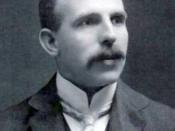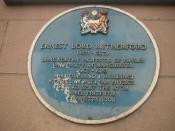SINCE ancient times, many models of the atom have been developed, as the result of people attempting to account for properties of matter they had observed. The model developed by Lord Ernest Rutherford introduced many new ideas about the atom, and even though it is now quite old, many people still see the atom in the way he did.
Rutherford was a former student of J.J. Thomson, but he thought there were inadequacies in Thomson's work. Thomson believed that atoms consisted of small negative charges embedded in a positively charged dough, and so his model is often referred to as the Plum Pudding Model.
Rutherford began investigating the properties of matter when he performed his now well-known Scattering Experiment of 1910. He fired alpha () particles from a radioactive source at a thin sheet of gold foil (400 atoms thick). The alpha particle source was enclosed in a lead box to prevent the particles from escaping in the wrong direction: only those that passed through the opening towards the gold foil were allowed to escape.
Fluorescent screens were used as detectors, and the impact of the alpha particles showed up on them. The results of the experiment were unexpected, but exciting. Almost all of the particles passed straight through the gold foil as if it was not there, and were detected on the other side. Some were deflected by small amounts, and very few by large amounts.
His task now was to attempt to explain these results. They did not fit Thomson's model of the atom, as in this model, there would not be a force strong enough to deflect some of the alpha particles. So Rutherford suggested that most of the atom consisted of empty space. This explained why the majority of particles had passed through the...


